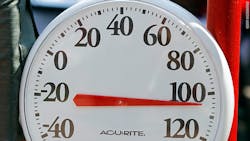When it comes to rated equipment capacity, is it 12,000 BTU/ton? Or, is it 9,200 BTU/ ton? Actually, sometimes it’s 14,300 BTU/ ton. In reality, equipment capacity will change for 10:00 am to 3:00 pm almost every day this summer. Let’s take a look at how you can determine the current rated capacity of the equipment you sell, install, and service at any time of the day.
It’s a really a hot summer afternoon. Your customer calls complaining the air conditioning isn’t keeping up. One valid reason it may not be keeping up is because the capacity of the equipment actually goes down as the outdoor temperature goes up.
How Manufacturer’s Rate Equipment
Cooling equipment is rated in a temperature-controlled booth under very exacting conditions according to published AHRI standards. These conditions have the outdoor air at 95F, with a return air temperature of 80F at 50% relative humidity (RH) which translates into a wet bulb temperature of 67F. The fan airflow is set to 400 CFM/ton.
Nobody I know is comfortable with the thermostat set at 80F. We rarely operate equipment under these conditions, but this is the baseline for the standard. Typically, under these conditions, cooling equipment is rated to deliver about 11,200 BTU/ton. But wait, there’s more …
In addition to meeting published AHRI standards, the manufacturers provide us with cooling performance tables for each piece of their equipment that shows how rated capacity changes as outdoor temperature, return air temperature, humidity, and airflow changes in our systems in the field.
When it gets warmer, cooling capacity goes down
From the table below we see that as outdoor conditions change, the cooling capacity of the equipment also changes.
- As the outdoor temperature moves up, the cooling capacity actually goes down.
- When the outdoor temperature gets cooler, the cooling capacity increases.
Consider the following changes in the capacity of this 3-ton unit:
|
Outdoor Temperature |
Rated Cooling Capacity BTU |
BTU Per Ton
|
|
65 |
37,700 |
12,300 |
|
75 |
36,200 |
12,000 |
|
85 |
34,900 |
11,600 |
|
95 |
33,000 |
11,000 |
|
105 |
31,000 |
10,300 |
|
115 |
28,700 |
9,600 |
Since more contractors are starting to measure and rate the operating efficiency of HVAC systems, determining the rated equipment capacity under different operating conditions becomes critical.
If you were to measure this 3-ton unit’s BTU delivery at only 31,000 BTU and you expect 12,000 BTU/ton, or 36,000, you would think the system operates poorly. But if you knew that 31,000 was its rated capacity at 105F, you’d be delighted with the results of your work.
Manual J and Manual S
Manual J is an industry standard that calculates the heat gain of a home in the summer and the heat loss of a home in the winter. Ideally, you need to choose an air conditioning system that removes the amount of heat equal to the calculated heat absorbed by the home to maintain indoor comfort. Manual J calculates the heat gain of the home under design conditions which are calculated on some of the hottest days of the year.
If the load calc comes in at 37,000 BTU and you stop there, you may eyeball the unit size at 3 tons or 36,000 BTU, based on the nominal tonnage of 12,000 BTU/ton.
Manual S requires you to look up the equipment’s rated capacity based on outdoor temperature, airflow/ton, and the desired indoor temperature to verify what the equipment rated capacity will be under design conditions. Manual S matches the equipment to the heat gain of the house.
Without this important step you may undersize the cooling equipment. Based on the table above, if outdoor conditions reach 105F, the equipment will only remove 31,000 BTU from the house, leaving your customers 6,000 BTU short each hour.
Manufacturer’s Websites
Actual cooling performance tables can be found at each manufacturer’s website. More engineering data is also turning up on search engines, just punch in the model number and see what pop’s up. You young folks with sharp vision can see most of this information in your smart phones.
Start collecting manufacturer’s cooling performance tables whenever you can. We’re hearing more customers have home office copy machines that they will let you use when you find well-preserved data in the attic or basement.
Should you encounter an ancient system where engineering data has slipped out of existence, contact NCI at the number below. Our tech support guys are always willing to lend a hand.
Rob “Doc” Falkeserves the industry aspresident of National Comfort Institute -- a training company specializing in measuring, rating, improving, and verifying HVAC system performance. If you're an HVAC contractor or technician interested in a free NCI Generic Cooling Capacity table to help you determine rated output this summer,contact Doc at[email protected]or call him at 800-633-7058. Go to NCI’s website at nationalcomfortinstitute.com for free information, technical articles, and downloads.About the Author
Rob 'Doc' Falke
President
Rob “Doc” Falke serves the industry as president of National Comfort Institute an HVAC-based training company and membership organization. If you're an HVAC contractor or technician interested in a building pressure measurement procedure, contact Doc at [email protected] or call him at 800-633-7058. Go to NCI’s website at NationalComfortInstitute.com for free information, articles and downloads.
